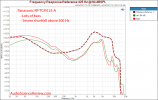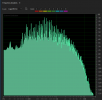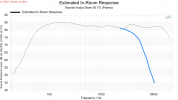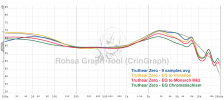Jumped on the bandwagon and bought a pair of these. On most music very nice and little to suggest there is any shortcomings. I really bought them because of all the hoopla about the Harmon Curve and how well these match it. Grand piano has always been one of the most revealing instruments for any playback set up. So after listening to everything else I moved on to Keith Jarrett live in Tokyo solo of Over The Rainbow. Hmmmm the upper registers just sounded hard and flattened. I thought ok maybe its the recording after all piano is notoriously difficult to get right. Took out my Etymonic 2SE in ear monitors. Wow I don't think I ever gave these the credit they deserve. Upper registers perfect, room ambiance perfect, low end damn good. If they aren't state of the art they close enough to forget the equipment and listen to the music. On sale at Amazon for $70 if anyone wants to see for themselves. And yes the deep ear placement might take a few try's to get used to. Took me a bit so maybe that's why I had set them aside for only airplane listening. But so glad I made the comparison.
-
WANTED: Happy members who like to discuss audio and other topics related to our interest. Desire to learn and share knowledge of science required. There are many reviews of audio hardware and expert members to help answer your questions. Click here to have your audio equipment measured for free!
- Forums
- Audio, Audio, Audio!
- Headphones and Headphone Amplifier Reviews
- Headphone & IEM Reviews & Discussions
You are using an out of date browser. It may not display this or other websites correctly.
You should upgrade or use an alternative browser.
You should upgrade or use an alternative browser.
TRUTHEAR x Crinacle Zero IEM Review
- Thread starter amirm
- Start date
staticV3
Master Contributor
- Joined
- Aug 29, 2019
- Messages
- 7,858
- Likes
- 12,553
oleg87
Senior Member
Was the cocha component of the ear gain as labeled in this graph a variable that was tested in determining preferences? If not, seems like it was worth exploring.Don't be fooled by the 'Research' in their name, Etymotic's 'science' is on extremely shaky ground. In fact, it's already been demolished:
The large majority prefer the Harman target. In their paper Segmentation of Listeners Based on Their Preferred Headphone Sound Quality Profiles, Harman identify three main groups of preference:

As that seems to be the most contentious part of the Harman IEM target beside bass region, given that SO many IEMs that have gained large followings systematically undershoot the Harman target there to various degrees.
Easy enough to tell how "revealing" any piano recording is. Listen to a live piano then listen to solo piano recording. Do you experience the same sense of body of the instrument, space around the instrument, dynamics from pianissimo to double forte, lower vibration, upper harmonics and everything in between. If you can get anywhere close to matching that you have a truly outstanding system. As I said I found the Truthear Zero's to be very nice but took on a artificial hardness and flatness in the upper registers. The Etymonic 2SE did not. I do understand that getting the Etymonic to seat deep in the ear canal is required for their performance. It's only in comparing the two that I have come to appreciate them as I now do. Whatever your preference is, enjoy the music.
using foam earbuds (3rd party memory foam of the grey ones they provide) stops all the microphonics...the standard earbuds are terribleI very much doubt Etymotic’s target is arbitrary and not based on some research *they* did on human hearing. I don’t know if there’s some sort of modal distribution of preferences here, but the er2xr sounds considerably more neutral to me than Harman (though the horrendous cable microphonics dampen my enthusiasm for them and there’s something about the upper treble/air region that sounds rather odd to me).
Though I doubt I’d like the flat-bass version. Even somewhat elevated bass in an IEM sounds far more anemic than flat-measuring bass on an over ear for some reason.
The industry standard is to match frequency responses at 500 Hz. Then you'll see that the Variations has the same elevation above target from ~1 to 2 kHz that the Truthear Zero suffers from which gives it its 'shouty' character, whereas the MH755 isn't elevated above target here so it doesn't.I'm interested in your opinion about my ultra minimalistic EQ for Zero with Variations as a target considering picture below
View attachment 243443
staticV3
Master Contributor
- Joined
- Aug 29, 2019
- Messages
- 7,858
- Likes
- 12,553
Always aligning at one frequency is stupid.The industry standard is to match frequency responses at 500 Hz.
For example, why would you align 500Hz here:

when aligning at 1750Hz makes the graph so much more readable:

Imo, you should look at the error graph, find areas, ideally plateaus that make sense to align at 0dB, and set those to zero.
Stubbornly sticking to one alignment frequency helps no one.
Another example:


Yep the non-5G variant has an output impedance of 5 ohms, so yours could well be just as high, which will definitely cause an audible difference.Interesting that it could be an output impedance difference that would cause my Pixel 4a 5G to have more sub bass.
Yeah the short cable on the MH755 is the only real downside. I keep telling myself I'll do the MMCX cable mod on it one day, but I've just been using a cable extension which works fine for me.I feel like after your post I need to try a pair of Sonys. The cable looks awful, though.
Always aligning at one frequency is stupid.
For example, why would you align 500Hz here:
View attachment 243611
when aligning at 1750Hz makes the graph so much more readable:
View attachment 243612
Imo, you should look at the error graph, find areas, ideally plateaus that make sense to align at 0dB, and set those to zero.
Stubbornly sticking to one alignment frequency helps no one.
Another example:
View attachment 243614 View attachment 243613
- Thread Starter
- #2,070
You have to pick a frequency that is not subject to large variations due to the fixture. Low frequencies are highly variable. And so are higher ups. That leaves a few hundred hertz as the right target.Stubbornly sticking to one alignment frequency helps no one.
staticV3
Master Contributor
- Joined
- Aug 29, 2019
- Messages
- 7,858
- Likes
- 12,553
Yes, if you have to pick one alignment frequency, then 400-500Hz is probably best.You have to pick a frequency that is not subject to large variations due to the fixture. Low frequencies are highly variable. And so are higher ups. That leaves a few hundred hertz as the right target.
But why do you have to? What's the benefit of doing so?
You simply pick the frequency that is best suited to what you want to do, that's all. If you want to evaluate how a specific pair of active headphones' feedback mechanism works in various modes, it makes sense to pick a frequency that is above the range where it operates, for example. If you want to assess the overall balance or tonal character of a pair of headphones, it can make more sense to pick an average over a span of a few octaves. If a pair of headphones has a high-Q feature right at 500Hz (some planar HPs for example), best avoid normalising them at the exact frequency.
I.e. you start from the end goal and work your way backwards from it. It's irrational to follow a standard for all applications in that regard.
I.e. you start from the end goal and work your way backwards from it. It's irrational to follow a standard for all applications in that regard.
Tried your EQ vs EQ to Variations & EQ to Monarch Mk2 and here's what I have found: I prefer one of them depending on listening volume level. The quieter I listen the more LF/HF I want. And that seems quite obvious considering loudness curves and this graphs:We are in agreement that the peak needs to occur at or before 3 kHz, and fall off faster than Harman IE 2019 above that.
And that is quite a bass boost
Attachments
Last edited:
There are good psychoacoustic reasons why the normalization frequency should be in the low to mid hundreds of Hz (note 800 Hz is a typo here, it should read 500 Hz, as Sean corrects himself below):For better optical interpretation of tonal character compared to a base/target curve I would personally rather take the fundamental tone region around 150-400 Hz, maybe a minimum RMS integral.
But there are also good practical reasons why it shouldn't be below 500 Hz, which only leaves 500 Hz as the best option:
So 500 Hz is the IEC standard for very good reason, in agreement with not only acoustic scientists like Sean who have been measuring headphones for over a decade, but the actual manufacturer of the measurement apparatus. And one of the fundamental reasons why the IEC have standards like these at all for data presentation (just as with measurements), both of which are common in many sciences, is to maintain as much objectivity as possible, minimizing subjective interpretation and the potential for massaging of the data (or methodology) to fit a narrative.
Last edited:
You think? I used an online tone generator and dragged the frequency slider around back and forth in the 18 Hz to 40 Hz region and listened to how it sounds - where the rolloff starts and how much of it there is. I determined that rolloff starts at 29-30 Hz, and arrived at a +8.4 dB low shelf filter at 28 Hz and 18 dB/oct.And that is quite a bass boost
I should probably add a sub-sonic filter, though, or change back from shelf to a regular peak.
That is a very smart consideration that totally slipped my mind. I know my current audio interface has a high heapdhone output impedance, something like 8 or 10 Ohms. But then I thought: "No problem, Zero's impedance rises in the bass region, so the high output resistance won't make as much of an impact, how convenient!" Doh. Thanks for pointing it out and educating me.Truthear have a stupidly low nominal impedance of just 10 ohms that rises considerably in the bass to sub-bass, so voltage division was likely meaning the bass was getting a boost
So, the awesome bass I already got used to is probably just bloated bass :/ And it did sound overdone in some tracks, but a lot of music is lacking proper base impact, Zeros with this crappy amplifier made that music much more fun. In that case, I might be disappointed when my Topping DX1 arrives.
Don't know what exactly you mean by "bloated bass". But from impedance measurement it seems that with high output impedance you'll get some increase mostly in subbass region which is lacking in Zero itself. So you probably have quite good bass right now. I'm thinking to try add 10ohm resistor and check. And I also waiting for IEC711 coupler to come.That is a very smart consideration that totally slipped my mind. I know my current audio interface has a high heapdhone output impedance, something like 8 or 10 Ohms. But then I thought: "No problem, Zero's impedance rises in the bass region, so the high output resistance won't make as much of an impact, how convenient!" Doh. Thanks for pointing it out and educating me.
So, the awesome bass I already got used to is probably just bloated bass :/ And it did sound overdone in some tracks, but a lot of music is lacking proper base impact, Zeros with this crappy amplifier made that music much more fun. In that case, I might be disappointed when my Topping DX1 arrives.
- Joined
- Jan 15, 2020
- Messages
- 6,880
- Likes
- 16,851
Like Sean Olive writes in the post you quote above from psychoacoustic point of view the anchor is similar to the one I wrote above, namely 200-300 Hz, he writes also the reasons they chose 500 Hz which are different. In the end every choice is a compromise (the ones of a single frequency have been already presented) and like @MayaTlab correctly writes the optimal representation depends on which field you want to investigate, that's why I wrote above "for better optical interpretation of tonal character compared to a base/target curve" and not "for standardised industry graphical comparisons of headphones".There are good psychoacoustic reasons why the normalization frequency should be in the low to mid hundreds of Hz (note 800 Hz is a typo here, it should read 500 Hz, as Sean corrects himself below):
But there are also good practical reasons why it shouldn't be below 500 Hz, which only leaves 500 Hz as the best option:
So 500 Hz is the IEC standard for very good reason, in agreement with not only acoustic scientists like Sean who have been measuring headphones for over a decade, but the actual manufacturer of the measurement apparatus. And one of the fundamental reasons why the IEC have standards like these at all for data presentation (just as with measurements), both of which are common in many sciences, is to maintain as much objectivity as possible, minimizing subjective interpretation and the potential for massaging of the data (or methodology) to fit a narrative.
Also few words about the IEC standard you mention as I had been participating in a similar working group for a new DIN/ISO standard (not acoustics), every standard is a also compromise and can also be modified in the future with the changing needs or be seriously flawed, see for example the criticism of Toole of the SMTPE/ISO target curve standards or the famous NEFZ car consumption cycle that was criticised a lot and later replaced by the more realistic WLTP.
Last edited:
This is where I (and Sean) disagree with you; they have the same requirements. Look at the context of Sean's tweets above. They're in reply to frequency response plots comparing different headphones to each other and the Harman target, precisely in order to 'optically interpret their tonal character'. And due to the variable nature of the measurements (e.g. leakage effects) and bass shelves of headphones as Sean notes, the normalization frequency should not be below 500 Hz if you want the most accurate estimation of perceived tonal differences."for better optical interpretation of tonal character compared to a base/target curve" and not "for standardised industry graphical comparisons of headphones".
I suggest you argue your case for a change in the standard with the IEC. Until (if) it changes, the current standard of 500 Hz should be used for consistency with professional scientific data, and so as not to confuse those new to seeing and interpreting headphone measurements by having everyone using their own non-standard normalization colored by personal bias and coming to different conclusions on the tonal character a measurement represents.Also few words about the IEC standard you mention as I had been participating in a similar working group for a new DIN/ISO standard (not acoustics), every standard is a also compromise and can also be modified in the future with the changing needs or be seriously flawed, see for example the criticism of Toole of the SMTPE/ISO target curve standards or the famous NEFZ car consumption cycle that was criticised a lot and later replaced by the more realistic WLTP.
Last edited:
Similar threads
- Replies
- 1K
- Views
- 192K
- Replies
- 1K
- Views
- 280K
- Replies
- 385
- Views
- 72K
- Replies
- 9
- Views
- 929



